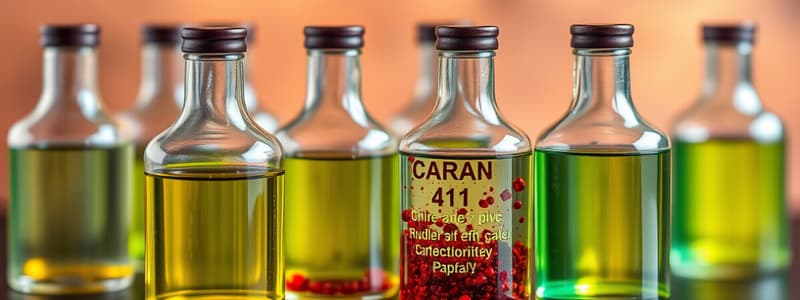Podcast
Questions and Answers
What differentiates isotopes of the same element?
What differentiates isotopes of the same element?
- They have different chemical properties.
- They have different numbers of neutrons. (correct)
- They have different numbers of electrons.
- They have different numbers of protons.
How is the half-life of carbon-14 relevant in the study of fossils?
How is the half-life of carbon-14 relevant in the study of fossils?
- It determines the exact age of the fossil.
- It helps in identifying the chemical composition of the fossil.
- It is used to calculate the time since the organism died. (correct)
- It indicates the stability of the isotope.
What process occurs when carbon-14 decays to nitrogen-14?
What process occurs when carbon-14 decays to nitrogen-14?
- Positron emission
- Beta decay (correct)
- Alpha decay
- Gamma decay
What characteristic feature of carbon-12 and carbon-14 allows them to be identified as isotopes of carbon?
What characteristic feature of carbon-12 and carbon-14 allows them to be identified as isotopes of carbon?
Why is carbon-14 continuously created in the atmosphere?
Why is carbon-14 continuously created in the atmosphere?
Which statement accurately describes the characteristic of the octet rule?
Which statement accurately describes the characteristic of the octet rule?
How do ions form from neutral atoms?
How do ions form from neutral atoms?
What is the main difference between ionic and covalent bonds?
What is the main difference between ionic and covalent bonds?
When sodium forms an ion, what happens to its electron configuration?
When sodium forms an ion, what happens to its electron configuration?
What process describes the movement of electrons from one element to another leading to bond formation?
What process describes the movement of electrons from one element to another leading to bond formation?
Flashcards are hidden until you start studying
Study Notes
Isotopes and Radioactivity
- Isotopes are variations of the same element with identical proton counts but differing neutron counts.
- Naturally occurring isotopes include carbon, potassium, and uranium.
- Carbon-12 has six protons and six neutrons, yielding a mass number of 12 and atomic number 6.
- Carbon-14 consists of six protons and eight neutrons, resulting in a mass number of 14; it retains atomic number 6.
- Some isotopes are unstable (radioactive) and decay over time to become more stable elements.
- Carbon-14 has a half-life of approximately 5,730 years, making it useful for dating fossils up to around 50,000 years old.
- Isotope decay rates can be measured through the concentration ratio of 14C in an object versus the atmosphere.
- Potassium-40 is utilized for dating older fossils due to its extended half-life.
Atomic Structure and Electron Configuration
- Electrons in an atom arrange in energy levels forming shells around the nucleus.
- The closest shell holds up to two electrons, filled before the outer shells can begin to fill.
- The second and third shells can accommodate a maximum of eight electrons each, adhering to the octet rule for stability.
- Chemical bonds form when atoms achieve stable electron configurations through interactions based on outer shell vacancies.
- Atoms become ions when protons and electrons are unequal, resulting in a net charge (+ for cations, - for anions).
Types of Chemical Bonds
- Ionic bonds occur when one atom donates an electron to another, leading to attraction between charged ions (e.g., Na+ and Cl- forming NaCl).
- Covalent bonds arise from sharing electrons between atoms, creating strong bonds prevalent in biological molecules (e.g., water, H2O).
Energy Concepts
- Energy is defined as the capacity to perform work and manifests in various forms: electrical, light, and heat energy.
- Thermodynamics studies energy transfer involving physical matter with key principles:
- The first law states energy cannot be created or destroyed but can be transformed or transferred.
- Living organisms convert energy from sunlight (photosynthesis) into chemical energy stored in organic molecules.
- The second law indicates all energy transfers lose some energy as heat, contributing to disorder (entropy) in a system.
- Higher entropy signifies increased disorder and lower energy states.
Kinetic and Potential Energy
- Kinetic energy relates to objects in motion, affected by speed and mass.
- Potential energy is stored energy based on position or structure, converting to kinetic energy when objects are set in motion (e.g., a lifted wrecking ball).
- Chemical energy resides within molecular bonds; when bonds break during metabolic processes, energy is released for cellular functions.
Studying That Suits You
Use AI to generate personalized quizzes and flashcards to suit your learning preferences.




